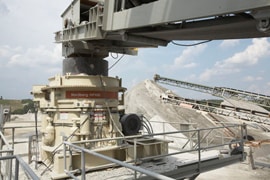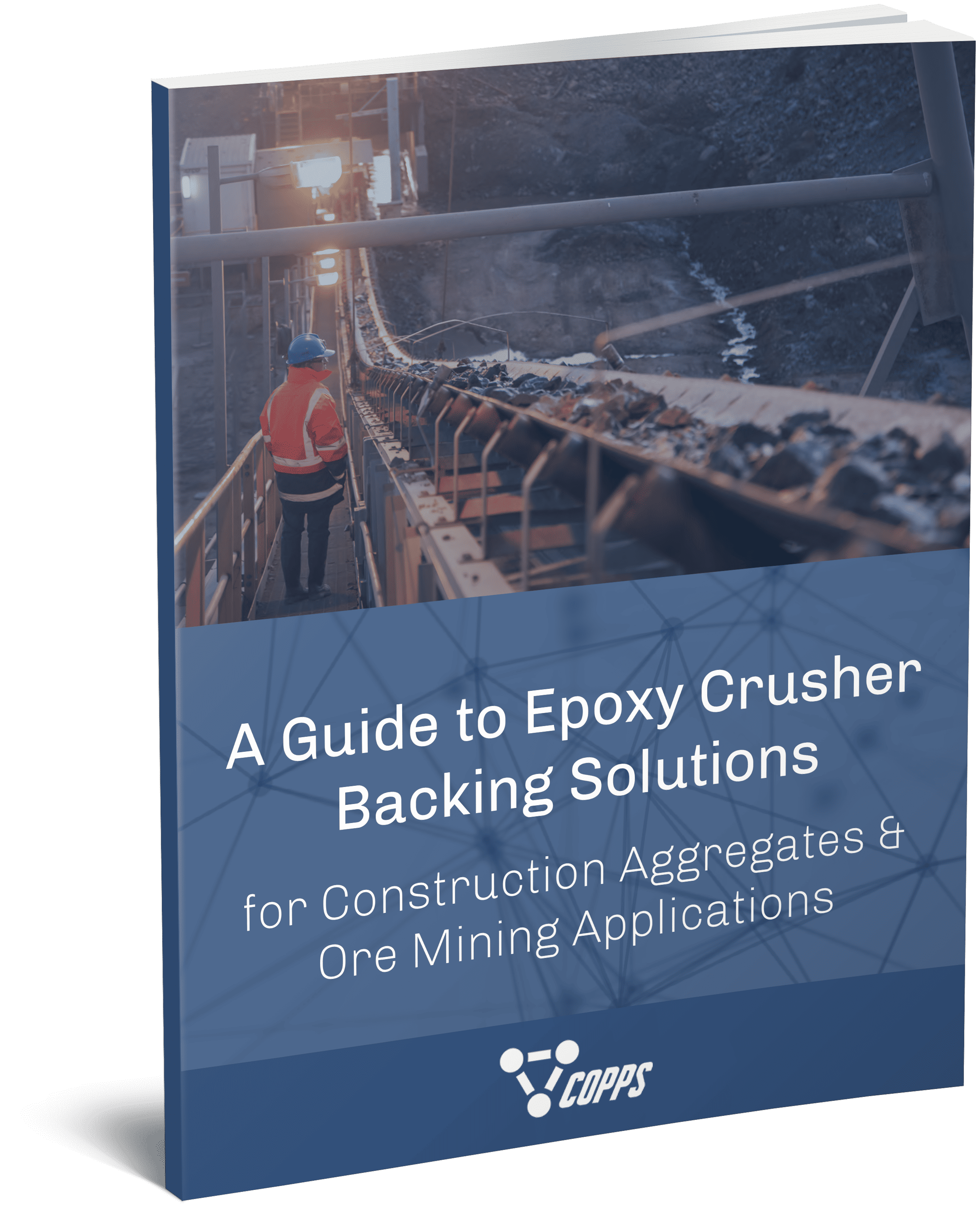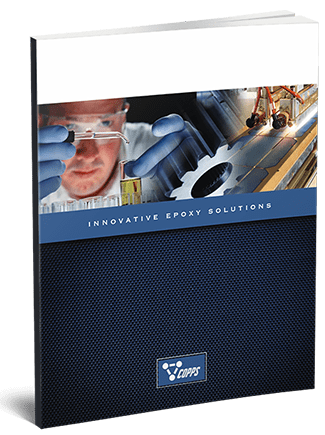
Copps Industries manufactures a complete line of 100% solids, crusher backing products. Including the premiere High Performance Backing XP-2000.
Crushing machines—also referred to as crushers—are designed to break large, dense materials (e.g., stone and ore) into more manageable forms. They are commonly used in quarries to reduce larger materials into smaller, size-specific pieces and aggregate plants to produce smaller rocks and powders for use in asphalt, concrete, and gravel.
Read on to learn more about the different types of crushers, the applications and importance of crusher backing compounds, and proper crusher maintenance.
What Is a Crusher?
Mines, aggregate processing operations, and other plants or job sites require heavy-duty equipment that can process raw materials for simplified removal or reuse. Mining crushers, large pieces of machinery that break down rock and aggregate materials into smaller pieces, are included in this category. Crushers are available in various sizes, depending on the needs of an operation. There are small units that are optimal for tasks requiring portable equipment, but often crushers are part of an overall material handling system. System components like conveyors or screening machinery will work together with crushers to effectively break or separate these raw materials.
Different models have different capabilities as far as the eventual size of the crushed material’s pieces. For example, an industrial rock crusher can splinter rocks into smaller, transportable pieces for reuse or disposal. Others break material down into gravel or pulverize it into a fine dust. Industrial crusher units exert large amounts of force and pressure onto materials, and so it’s important that the machinery itself be able to handle shock, vibration, and the counteracting forces—especially because most quarries and mines are remote, potentially making maintenance difficult, and these critical operations can’t afford unscheduled downtime.
How Does a Rock Crusher Work?
At quarries or mines, operators will place rock, ore, and related raw materials into the empty cavities in a crusher. Once these chambers are full, the crusher will shift its rugged, moveable jaws or plates together, using heavy levels of force to break the material in between them down into much smaller pieces. The jaws might also move up and down to quickly jostle and crumble the rock. Once the crusher breaks down or pulverizes the materials within its cavity, the chamber can be emptied and then refilled with a new load.
As it varies by model what the size of the output pieces will be, mining and aggregate operations will sometimes utilize more than one crusher as part of a circuit to fully do the job. For example, a quarry might have a jaw crusher for the initial heavy-duty work that turns extremely large and heavy pieces of rock and ore into more manageable sections. From there, the material might proceed to another crusher that can further break it down for easier processing, removal, or use in concrete, gravel, or other aggregate products.
Types of Crushing Operations
Crushers use a variety of different motions, forces, and overall styles of crushing in order to best produce the broken-down product in the intended size as efficiently as possible. Crushing applications typically fall into four categories:
- Attrition. Crushers that use attrition to separate materials will churn raw materials around within the equipment, using a side-to-side motion and the resulting impact of the material contents to break them down into reduced, appropriately sized pieces. Crusher machines that perform this abrasion process are often known as grinders.
- Compression force. Crushers capable of this type of processing use compression force and rising pressure to ultimately break a material, squeezing it between two surfaces.
- Impact. This crushing operation also uses compression force, but impact crushing as a process is more severe. Rather than the two crushing surfaces simply pushing together, impact crushers drive the crushing surface toward the second surface, striking the raw material in between over and over to crush it through impact force.
- Shearing. The crusher equipment that carries out shearing tasks achieves cuts by using the edges of dual surfaces to split a workpiece.
Crushers operate on a very basic mechanical principle—rock is compressed between two harder surfaces until it breaks into smaller pieces. As the crushed materials are typically quite hard on their own, the crushing process causes significant wear and tear on crushing machines. For this reason, many crushers are integrated with crusher backing compounds.
At Copps Industries, we manufacture a complete line of epoxy-based crusher backing compounds. These durable and shock-absorbing materials play a pivotal role in the protection and reinforcement of heavy-duty mining and quarry equipment.
Applications of Crusher Backing
Crusher backing compounds protect crushing machines from unnecessary damage and long-term wear by filling the open cavities behind wear parts and supporting (i.e., backing up) wear surfaces. In doing so, they minimize the effect of friction, vibration, and impact on the machinery during crushing operations.
The Copps Industries team continually improves on the formulation of products using the most current raw materials to accommodate the needs of even the most demanding applications. Through these unique innovations and our tried-and-true standard product line offerings, we offer a broad selection of crusher backing compounds to suit the requirements of any crushing application or operation. For example:
- Our non-corrosive bushing lock is the industry standard for use eccentric assemblies. It “locks” the inner and outer eccentric bushings, preventing them from turning and, consequently, reducing the opportunities for wear and extending equipment life.
- Our cold cure crusher backing, our most recently developed product, is a high-performance material designed for use in air temperatures between 25° F and 60° F (-4° C to 16° C).
Our products find use in a variety of crushing equipment, including the following:
Cone Crushers
Cone crushers are a form of compression crushing machines, which reduce the size of materials by squeezing or crushing them until they break. They consist of an eccentrically rotating steel component (i.e., the mantle) and a stationary steel component (i.e., the bowl). As the material moves from the top of the cone down, it is crushed into smaller and smaller pieces until it is small enough to exit through a hole at the bottom. The final size of the material is determined by the bottom gap between the two crushing components (i.e., the close side setting).
Gyratory Crushers
Gyratory crushers are similar in shape and operation to cone crushers. However, their moving crushing components gyrate (i.e., oscillate along a circular path) rather than rotate. The crushing head can be height-adjusted, and the hole at the bottom of the crushing chamber determines the final size of the crushed material.
Stone Crushers
As suggested by the name, stone crushers are designed to break stone into smaller pieces. They can be used to process a variety of stone materials, ranging from soft minerals to hard stones, for various industrial applications (e.g., chemistry, demolition, metallurgy, mining, etc.). They are available in a wide range of designs and configurations to suit different crushing requirements, including cone crushers, hammer crushers, impact crushers, and jaw crushers.
Grinding Mills
Grinding mills are used to reduce raw materials to a powder form. While their design and configuration can vary, they generally consist of a rotating grinding chamber with balls, rods, pebbles, or other grinding media to break up the material into the desired size.
Backing Plates
Backing plates are used in crushers and grinders to provide protection from loose material impact, vibration, and noise. By mitigating the effect of impact and vibration on equipment, they reduce overall maintenance costs and extend overall service life. Additionally, by lowering noise levels, they protect the hearing of personnel working in close proximity to crushing equipment.
Lock Bushings
Lock bushings are engineered to allow for quick and easy installation of other components to shaft assemblies. They securely fasten components without the risk of loosening even when exposed to high impact and vibrations, which makes them ideal for use in mining and quarry equipment.
Advantages of Crusher Backing Compounds
Crusher backing compounds offer a range of benefits for mining and aggregate operations, such as:
- Extended Machinery Life. Crushing is an extreme operation. It generates significant vibration and impact forces, which can reduce equipment life. Applying crusher backing compounds on an appropriate maintenance schedule substantially extends the life of equipment and related components, minimizes downtime, and lowers replacement part costs.
- Low Shrinkage. During the hardening or curing stage, controlling the shrinkage of the crusher backing is critical to a successful pour. Using a properly formulated crusher backing compound engineered to manage shrinkage greatly reduces the risk of voids and misalignments between liners.
- High Strength. Crusher backing compounds offer a higher level of compressive strength, a broader array of service temperatures, and higher impact and vibration resistance. This level of toughness greatly improves the efficiency and durability of protected components and machinery.
- Gap Elimination. By eliminating wear liner gaps and smoothing alignment errors, crusher backing compounds provide equipment with superior impact resistance compared with equipment not treated with a crusher backing compound.
Enhanced Safety. Before the invention of epoxy crusher backing compounds, molten white metal (i.e., zinc) was used as a crusher backing material. However, this process involves working with high-temperature materials, which creates unnecessary safety hazards for workers.
Types of Crusher Maintenance
In addition to selecting the right crusher backing compound for a crusher and applying it properly, it is important to periodically inspect and service crushing equipment to ensure it remains in optimal operating condition. Otherwise, there is a risk of the crusher backing compound degrading without notice and the crusher being exposed to harsh conditions.
There are three maintenance methods available:
- Reactive maintenance. This method involves fixing components only once they break. While it is initially cheaper, it often entails greater downtime than the preventative or predictive maintenance methods.
- Preventative maintenance. This method involves scheduling inspections at regular intervals to hopefully identify and replace worn parts before they become an issue.
- Predictive maintenance. This method involves identifying the expected service life of each component and replacing them as needed.
Investing in a maintenance plan that incorporates all of these maintenance methods, especially preventative and predictive maintenance, can help ensure crushing equipment remains in operating condition for the duration of its expected service life.
Learn More
With sales and support in 27 countries, Copps Industries is a well-known name in aggregate plants, quarries, and mines throughout the world. Our 100% solids, VOC-free crusher backing products have been in use for over 30 years. This line of products ranges from our workhorse-standard backing to our high-performance backing to our industry-leading non-corrosive products.
To learn more about our crusher backing compounds or other epoxy-based solutions, contact us or request a quote.
| Product | Viscosity @25°C cps |
Pot life @ 22°C, min. |
Curetime @ 22°C hrs. |
Compressive Strength, psi |
Heat Distortion Temperature, °F |
Impact Strength, notched izod,lbs.in |
Water Absorption 30 days @ 22°C, % |
Safety Data Sheet (SDS) |
Technical Specs |
|---|---|---|---|---|---|---|---|---|---|
| K-001 Standard Backing | 8,000 | 20 | 6 | 16,500 | 161 | 4.1 | 0.42 | ||
| K-085 XP-2000 High Performance | 7,500 | 25 | 6 | 18,000 | 200 | 4.9 | 0.25 | ||
| K-817 Non-Corrosive Standard | 10,000 | 20 | 6 | 15,000 | 133 | 3.5 | 0.48 | Login to access the Safety Data Sheets (SDS) |
|
| K-831 Non-Corrosive High Performance | 8,000 | 20 | 6 | 17,000 | 187 | 4.2 | 0.27 | Login to access the Safety Data Sheets (SDS) |
|
| K-004 TROWELBAC | soft paste | 45 | 6 | 10,000 | 147 | NA | 1.78 | Login to access the Safety Data Sheets (SDS) |
|
| K-016 Non-Corrosive TROWELBAC | soft paste | 45 | 6 | 13,000 | 134 | NA | 0.56 | Login to access the Safety Data Sheets (SDS) |
|
| K-113 Non-Corrosive Bushing Lock | 10,800 | 15 | 8 | 13,800 | 197 | NA | 0.43 | Login to access the Safety Data Sheets (SDS) |
|
| K-024 Cold Cure Backing | 4,000 | 7 | 6 | 18,700 | 153 | 3.9 | 0.49 | Login to access the Safety Data Sheets (SDS) |

Download Our eBook
Due to the demanding conditions commonly found in mining and aggregate applications, crushers experience significant amounts of stress. If crusher liners are not properly supported, the extreme crushing forces and impact generated during operations can cause premature failure of these wear components. One solution industry professionals rely on to maximize the production of their equipment is epoxy crusher backing compound to extend the life of the crusher liners.
Learn More







